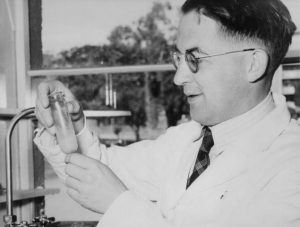Fred Collins Award

Fred Collins in the lab at ANU, 1956.
In 2011, the Collins family kindly established an award to honour the role that Fred Collins played in the establishment of the Australian Biochemical Society. The Fred Collins Award is awarded to the most outstanding ASBMB Fellowship applicant and includes $1000 in addition to Fellowship travel expenses.
Frederick Darien Collins
Ngati Raukawa
1918-1974
Fred Collins in the lab at ANU, 1956.
Fred Collins was born in Palmerston North, New Zealand, and educated at King’s College Preparatory School and Correspondence School. He attended Victoria University of Wellington and graduated with a BSc in 1939 and an MSc with 1st Class Honours in Chemistry in 1940. From 1941 to 1946, he was Research Officer for the New Zealand Department of Agriculture. From 1946 to 1949, he was a New Zealand National Research Scholar in the Department of Biochemistry at Liverpool University, England, obtaining his PhD in Biochemistry in 1949.
He was an ICI Research Fellow in the Department of Biochemistry, Liverpool University from 1949 to 1952, continuing to work with his PhD supervisor, Professor Richard Morton, on the biochemistry of vision. This work explored the involvement of vitamin A and certain other lipid molecules in the vision process and led to a significant expansion in our knowledge of the underlying chemical changes and chemical molecules associated with vision. The results of the work were published in 21 scientific papers, mainly in Nature and Biochemical Journal.
In 1952, he took up an appointment as Senior Research Scholar in the Department of Biochemistry, Australian National University (ANU), and began a research involvement with a class of lipid molecules, the phospholipids, which was to occupy his attention for the remainder of his life. He worked at ANU until 1958 and during this period explored the basic chemical structure of the phospholipids, a group of molecules closely associated with the structure of all living cells; the results of this work appeared in six scientific papers.
Collins was the first Treasurer of the Australian Biochemical Society (ABS) in 1955 and was its second Secretary from 1956 to 1961. He was also Advisory Editor of the journal Chemistry and Physics of Lipids during this period.
He moved to the Russell Grimwade School of Biochemistry, University of Melbourne, in 1958, as an NHMRC-funded researcher. Collins was ahead of the rest of the scientific world in appreciating the importance of phospholipids in cellular function and his persistence was rewarded in 1960 when he demonstrated that not only did these molecules actively turn over (form and break down), but that different molecules were turning over at quite different rates. The results were published in Nature in 1960 and represented a turning point in the importance attributed to these molecules by biological scientists.
His research into the behaviour of the phospholipids led to the discovery that the fatty acid moieties present in a molecule determine its biological function. He was able to relate these findings to a developing research interest in a class of molecules known as the essential fatty acids, molecules required in the diets of animals in order to ensure proper nutrition and development. He demonstrated that individual molecular species of phospholipids containing essential fatty acids moieties behaved quite differently from those containing non-essential moieties.
Collins also detected the presence of an anomalous fatty acid in animals with diets devoid of essential fatty acids and argued that this was chemical indicator of a syndrome known as essential fatty acid deficiency. It was argued by many scientists that essential fatty acid deficiency would never be a human problem, but in 1970, he was able to show the presence of the clinical indicator in a patient with liver cancer and in another patient restricted to intravenous nutrition. The latter finding has had tremendous significance for the composition of intravenous food supplements and led to the commercial development of a range of intravenous nutrition formulations containing essential fatty acids. It also added impetus to the need to answer questions about the appropriate composition of infant formulas and led, in part, to the development of vastly improved infant supplements replete in essential fatty acids.
Collins also devoted research effort in the early 1970s to the composition of the various serum lipoprotein fraction, which turned out to be important in the assessment of cholesterol as a risk factor for coronary heart disease. His main research effort in the later years of his life was spent investigating the basic biochemistry of essential fatty acids in skeletal muscle phospholipids and the last results from this work were published in 1977.
Fred Collins died prematurely in 1974. His contribution to biochemistry (including 66 publications) was tremendously important and had impacts in areas that continue to affect a very large number of people. His own ideas and those of the students he trained continue to influence the direction of research in the field of essential fatty acid and phospholipid function.
In 1946, he married Winifred Tuck, a fellow researcher at the New Zealand Department of Agriculture; she died in 2009. Fred and Win are survived by their three children and eight grandchildren.
Maurie Trewhella and Bridget Underhill
ASBMB Membership Office
T +61 (03) 9907 8648
E asbmb@wsm.com.au
© 2022 ASBMB. All rights reserved.